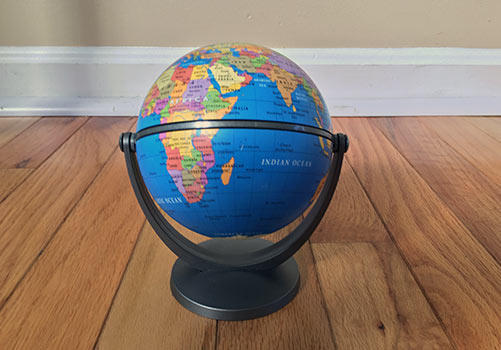
In a recent family discussion, we were looking at a little globe, spinning it around and looking at all the different places on the earth. As we spun the little globe and talked about the earth’s circumference and how deep oceans are, we waded into an particularly interesting and perplexing question.
On earth, we all agree that directional north points upward and that the North Pole is the top of the world and that the South Pole of is the bottom of the world. We discussed how we see this view of earth reflected from photos taken by satellites and by astronauts as they travel space.
As this conversation progressed, we began to talk about whether what we call directional north (i.e., the North Pole) really is up. Could it be possible that it just appears that way to us, given our current understanding of the universe and the scientific and mathematical tools available to us in this modern age? Might our own understanding be faulty given the limits of our current perspective? Might we need some modern day Copernicus to bring us closer to the “true” reality?
Our family conversation did not end with a definitive solution to the question.





North is not ‘Up’, it’s, well, North! If you look ‘Up’ into the sky, you are not looking North, you are looking ‘Up’… not the same thing. I actually had a teacher in high school that tried to correct his students when referring to North as ‘Up’… you don’t live ‘Up’ North… you live in the Northern part of the country. A good conversation, but taken literally from the dictionary… “toward the sky or a higher position”, North is clearly not ‘Up’.
No. There is no up in space. We say up is up because we live in a gravity well. When you go into space and no longer feel gravity, you realize that up is a rather silly idea. The reason North is always to the top is a map makers convention. It makes it easier to read a map or globe.
There are two real physical “norths” to the planet. One the “north” pole of the axis of rotation of the earth. Which pole we call north and which we call south is completely arbitrary. Another one is the magnetic north which is in a different place than the axial north pole. There is nothing in physics that says that that pole has to stay anywhere near the north axial pole. Evidence indicates that it may have flipped many times in the last few billion years. Also, what we call the north magnetic pole is actually the south pole of the the Earth’s magnetic field. This is because we called the side of magnets that had pointed north the north pole of the magnet, but with magnets opposites attract. So the north pole of a bar magnet points toward the south pole (what we call the north pole) of the earth’s magnetic field.
So, not only is north up because we say it is. It is north only because we say it is.
I think the reason that most people on Earth view North as toward the top of Earth is because most people, both historically and present day, live in the Northern Hemisphere
Like anything of this sort, north being up is a convention. Map makers drew there maps so that north was at the top. The first maps were drawn by using the position of the stars. Map makers in the northern hemisphere had a very useful tool for map making. They could instantly find their latitude by measuring the angle of Polaris in the sky. As such it made sense to make this direction up. North is a Germanic word that comes from roots meaning “left” or “below”. the reason it was ascribed to its particular cardinal position on maps is because it is to the left of the viewer facing the rising sun. Somewhat ironically the Sanskrit root for north took part in their word for hell. Back then the root was more associated with the down direction, literally meaning “below” or “underneath.”
Also of interest, the modern Romantic languages got their words for North from Old English (e.g, “norte” in Spanish) The Latin word for north is actually borealis. English has a cognate in boreal, an adjective meaning of the North or northern.
*their